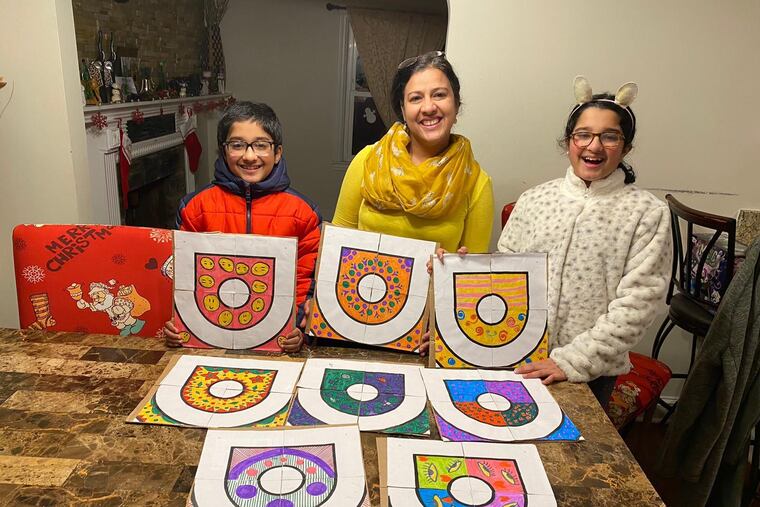Designs from Philly-area residents part of the Kolam Project, which welcomes first South Indian vice president
The grassroots effort celebrates not only Kamala Harris’ heritage, but serves as a way to “showcase the multicultural heritage of America.”

As a child growing up in the southern state of Kerala in India, Sindu Gopalakrishnan helped her mother draw kolams with rice powder outside the family abode on festival days. The ancient Indian art form of geometric patterns is a sign of welcome and new beginnings.
In the waning days of 2020, the 43-year-old Phoenixville resident who works in investment banking once again drew kolam (pronounced KOHL-uhm) designs. This time, it was to welcome the new Biden-Harris administration, and particularly Kamala Harris, the country’s first vice president who is a woman, and who has roots in South India.
Along with her 18-year-old daughter, Devika Nair, Gopalakrishnan used markers and paints to color 17 pieces of 12-by-12-inch cardboard as part of a project to create a giant kolam art installation in the nation’s capital. “This is a tradition usually seen in India,” she said. “We never knew we would be designing kolams here ... for one of the American streets in D.C. It’s welcoming a new day.”
Known as the 2021 Kolam Project, the grassroots effort celebrates not only Harris’ heritage, but serves as a way to “showcase the multicultural heritage of America,” as well as the new administration’s promise of a “presidency for all,” say the organizers on the www.2021kolam.com website. Originally, the 2,500-square-foot, 47-dot kolam was planned as an installation outside the White House, but security concerns made that impossible.
Instead, the group got approval to place the design outside the U.S. Capitol. Then the attack of Jan. 6 happened, and the subsequent lockdown of Washington, D.C., put those plans on hold, with hopes for an installation at a later date. Meanwhile, the project was featured in a nearly five-minute clip during the virtual “America United: An Inauguration Welcome Event Celebrating America’s Changemakers” on Saturday.
At last count, 2021 Kolam Project had received more than 1,800 tiles from people around the country, plus many more submissions through a call for selfies taken with a kolam, said Roopal Shah of Washington, D.C., who is one of the project’s volunteer organizers. The selfies will form a virtual mosaic photo that is expected to post to the group’s website Wednesday.
Participants, ranging in age from 5 to 95 years old, were encouraged to use the backs of old campaign signs (of any stripe) to create the tiles. Yoga studios, classical Indian dance students, and 10 D.C. public schools, in addition to hundreds of ordinary people, all contributed, incorporating bits of themselves into the designs.
» READ MORE: Kamala Harris follows Kaw Nation’s Charles Curtis as the second person of color to become vice president
“Folks who lost somebody to COVID poured their love and grief into their tiles,” Shah said. “Folks made a family project, where everybody colored.”
The dots and lines that make up a kolam that many women in South India redraw each morning to greet the sunrise is an art form reminiscent of the ephemeral and meditative aspects of Native American sand paintings and Buddhist mandalas. The Inaugural Day kolam was designed using the submissions by Maryland artist Shanthi Chandrasekar, the project’s curator, who has described the dots in a kolam as depicting life’s struggles, and the lines drawn around them as representing ways around those struggles.
“It’s the mosaic of life,” Shah said. “It manifests the times we’re living in.”
For many Indian Americans, the 2021 Kolam Project also “enables us to welcome all of our stories into this new space that’s being created in America,” Shah says, “to be part of the healing, to bring people together, to weave these stories together.”
Nair, a freshman at the University of Pittsburgh who is home on break, said making kolams was a way to connect with her heritage and with family. “I painted one with a blue background and drew peacocks on it, and it reminded me of the ones my grandma used to draw in India,” she said. “I also got to hear some of my mom’s childhood memories.”
In addition, Nair said she was excited to be a part of the inauguration celebrations: One of her tiles features the U.S. flag. “I’m very proud that my cultural heritage will be represented within the government,” she said.
For Anita Singh, 40, of Media, participation began as a family activity over the holidays. She, her husband, and their 9-year-old twins joined forces with five other families to create 35 tiles.
“It was fun and festive,” said Singh, chair of the biomedical engineering department at Widener University.
The families got together via Zoom to color the tiles and kept tabs on each other’s progress over two weeks through a WhatsApp group. Her son, Adi Iyer, an aspiring astronaut, colored his tile with spaceships. Her husband, Sriram Balasubramanian, wrote Joe Biden and Kamala Harris on his tile in the scripts of seven Indian languages.
While Singh is disappointed that the installation has been postponed, she says the joy of creating the tiles more than made up for that. Before she sent the 35 tiles to the 2021 Kolam Project, she laid them out.
That moment, Singh said, “really symbolizes us coming together as a community, as a country.”
Contact at LKadaba@gmail.com. Follow @KadabaLini.